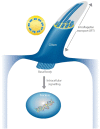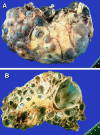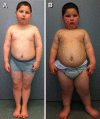Educational paper: ciliopathies
- PMID: 21898032
- PMCID: PMC3419833
- DOI: 10.1007/s00431-011-1553-z
Educational paper: ciliopathies
Abstract
Cilia are antenna-like organelles found on the surface of most cells. They transduce molecular signals and facilitate interactions between cells and their environment. Ciliary dysfunction has been shown to underlie a broad range of overlapping, clinically and genetically heterogeneous phenotypes, collectively termed ciliopathies. Literally, all organs can be affected. Frequent cilia-related manifestations are (poly)cystic kidney disease, retinal degeneration, situs inversus, cardiac defects, polydactyly, other skeletal abnormalities, and defects of the central and peripheral nervous system, occurring either isolated or as part of syndromes. Characterization of ciliopathies and the decisive role of primary cilia in signal transduction and cell division provides novel insights into tumorigenesis, mental retardation, and other common causes of morbidity and mortality, including diabetes mellitus and obesity. New technologies ("Next generation sequencing/NGS") have considerably improved genetic research and diagnostics by allowing simultaneous investigation of all disease genes at reduced costs and lower turn-around times. This is undoubtedly a result of the dynamic development in the field of human genetics and deserves increased attention in genetic counselling and the management of affected families.
Figures






References
-
- Adeva M, El-Youssef M, Rossetti S (2006) Clinical and molecular characterization defines a broadened spectrum of autosomal recessive polycystic kidney disease (ARPKD). Medicine (Baltimore) 85(1):1–21 - PubMed
-
- Bae KT, Zhu F, Chapman AB, et al. Magnetic resonance imaging evaluation of hepatic cysts in early autosomal-dominant polycystic kidney disease: the Consortium for Radiologic Imaging Studies of Polycystic Kidney Disease cohort. Clin J Am Soc Nephrol. 2006;1:64–69. doi: 10.2215/CJN.00080605. - DOI - PubMed
Publication types
MeSH terms
LinkOut - more resources
Full Text Sources

